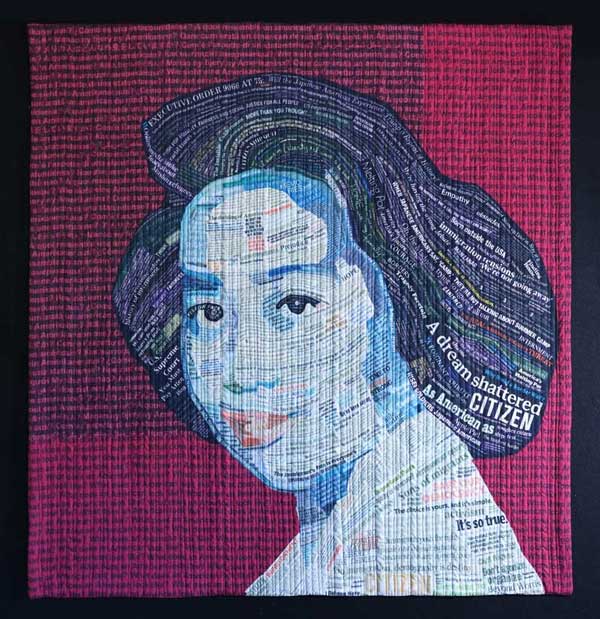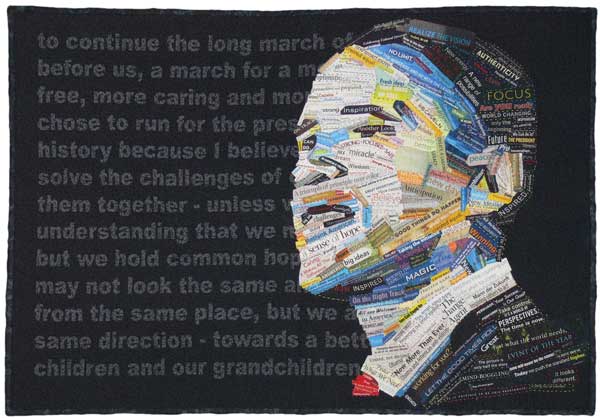This is Kris with some more thoughts on the Black Lives Matter movement. It has been a little over a month since George Floyd was murdered by a police officer in Minneapolis, Minnesota. We already wrote about our support of the movement here, but we wanted to share a couple of our artworks again within this historical framework.
The Picture is Only Half the Story
After the election of Barack Obama, we – as well as much of the country – thought we were on the verge of a new era in which equality would soon reign. I think we still are, but the death throes of racism are mighty, and we are living right through them. We titled this piece, “The Picture is Only Half the Story” because we knew there was so much more to this particular election of the first African American president. Think about it. The year was 2008, and Obama was the first Black person elected to the presidency.
Another reason for the title was an acknowledgment of how difficult it was for Obama to actually get elected. While we placed all our hopes and dreams (in text) on his face, the words that form the background of the piece are from his speech on race. When Obama’s candidacy was almost derailed because of his association with the controversial pastor, Rev. Jeremiah Wright, he delivered what Deb and I considered his most important speech of the campaign. You might want to take a second look at it. It is still inspiring and gives us hope again that we may someday form that more perfect union.
Click here to read our blog post on this piece.
Click here to read the transcript of Obama’s speech.
Click here to read the Washington Post‘s review of this speech. From there you can peruse the rest of the WP’s “Obama: A Virtual Museum of his Presidency.”
What Does an American Look Like?
One of the consequences of the recent protests has been the renewed call for the dismantling of monuments dedicated to supporters of slavery and slaveholders themselves. Statues of Robert E. Lee or other members of the confederacy are finally getting removed. We know not only the tarnished history of the men themselves, but the history of the erection of these statues. (Click here to read more about the history and the continuing support of confederate monuments.)
[F]ar from simply being markers of historic events and people, as proponents argue, these memorials were created and funded by Jim Crow governments to pay homage to a slave-owning society and to serve as blunt assertions of dominance over African-Americans.
Smithsonian Magazine Dec 2018
For many, deciding to stop the support of memorials dedicated to the slave-owning society seems pretty easy, and I feel confident that these statues will all be removed from their public locations. But looking again at “What does an American Look Like” brings up the difficult issue of statues in general.
The subject of this piece is Mitsuye Endo, the Japanese American whose case of illegal incarceration during WWII ended in the Supreme Court’s landmark decision to disband the incarceration camps. And how did these camps come into existence in the first place? Well, it was President Franklin Roosevelt’s executive order 9066. Yes, perhaps the most consequential president of the twentieth century is to blame for unconstitutionally incarcerating 120,000 Japanese Americans. Do we take down all the statues of FDR? I don’t have the answer to that one, but it’s a conversation I think we as a country need to have.

The California legislature recently announced that it would remove the statue of Christopher Columbus from the rotunda of the state’s capitol building in Sacramento. I won’t argue the (de)merits of Columbus here, but should people want to put a different statue in the rotunda, I want to be part of that conversation.
There are many deserving of the honor, but I see value in placing a statue of Endo there. A native Sacramentan, she worked for the government until her unconstitutional incarceration during WWII. She stayed in the camp when she could have had early release in order for the case to be heard at the Supreme Court. She stands as a symbol for the best of America; that we can look back on the ugly parts of our history, acknowledge them, and go about repairing them. And that is why this Black Lives Matter movement is so important. Let us reassess our history and (re)discover those parts that need acknowledgment and repair.


4 responses to “Because It Bears Repeating: Black Lives Matter”
Thank you for a thoughtful inspiring and much needed statement. Well said.
Thanks, Linda.
A well thought suggestion. I hope there will be serious thought given to the proposal.
Thanks, Linda. I’ll have to actually make a formal proposal to my state legislator!